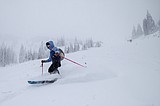Citizen work group recommends no-wake zone for Half Moon Slough
KATE HESTON | Hagadone News Network | UPDATED 2 years, 10 months AGO
Kate Heston covers politics and natural resources for the Daily Inter Lake. She is a graduate of the University of Iowa's journalism program, previously worked as photo editor at the Daily Iowan and was a News21 fellow in Phoenix. She can be reached at [email protected] or 406-758-4459. | February 16, 2023 11:00 PM
A resident group is recommending that the state Fish and Wildlife Commission emplace a no-wake zone on Half Moon Slough at its April meeting.
The recommendation, which includes a seasonal closure for migrating waterfowl, arose out of a nearly three hour long meeting in Kalispell on Wednesday of a citizen work group dedicated to concerns about erosion on the slough bank of the Flathead River. Montana Fish, Wildlife and Parks created the body after receiving a petition from landowners near the slough highlighting worries about the future of the area.
The petition, submitted last year, asserts that man-made wakes have eroded over 25 feet of bank in the slough, getting closer and closer to a county road known as Siberlud Lane, threatening land loss and the possible creation of a public access point.
The Feb. 15 meeting included nine interested individuals, many of whom live near the slough, and officials with the state agency, including a biologist and game warden.
“We just need to be good stewards of the land, both fisherman and boaters and the landowners,” said Emmett Quigley, the property owner behind the petition effort.
Members of the Stebbins family, who have lived on the land for generations, attended the meeting in support of state-imposed boating restrictions.
“If we have people slow down, and not cause the kind of wake action that’s going on, we’ll have less land loss,” said Tom Saubert, who married Marilyn Stebbins. “It comes down to being that simple.”
But another family with longstanding ties to the area pushed back on the effort. Lonnie Siblerud, the representative for Siblerud Properties LLC, sent an email expressing the family’s disagreement with Quigley’s petition. A resident of Washington, Siblerud wrote that he was unable to travel to attend the meeting in person.
“I believe that the erosion in the pictured area of the petition is due mainly to the weather, wind and high water during the spring runoff each year,” Siblerud wrote.
He wrote that the family supported adding buoys to the slough, and that members would agree with putting riprap in the eroded area as a fix.
State officials pointed out that a boating regulation would necessarily come before the installation of buoys. Dillon Tabish, Region 1 information and education program manager, said that efforts like installing riprap fell beyond the purview of the state wildlife agency or the Fish and Wildlife Commission.
Lu Ann Borgen, a member of the Siblerud family in attendance, said the family worried that a no-wake zone would prevent their use of the slough.
A no-wake zone is an area where boats must travel at a speed where there is no white water in the track or path of the vessel. Boats could still enter the slough with the restriction, they just have to maintain an appropriate speed.
Supporters, though, acknowledged that a no-wake zone is just one piece of the puzzle.
“We can recognize that it's not just boats that add to the erosion, but then we have to come up with some ideas of things we can do,” Donna Stebbins said. “It's partly from the high water and stuff, but those are things we can’t control. But we can control the speed of the boats.”
Half Moon Slough covers about 32 acres and stretches three-fourths of a mile long. The slough is around 400 feet wide, making any sort of wake restriction linked to distance from the shoreline difficult to enforce.
According to state rules, any lake 35 acres or less automatically gets a no-wake zone designation, Tabish said. Since the slough is part of the river, that automatic designation does not apply.
For lakes larger than 35 acres, there is a designated no-wake zone extending 200 feet from the shoreline.
The group also discussed other sloughs that have a no-wake zone, like Fennon Slough. Restrictions came at the behest of residents.*
Toward the end of the meeting, Borgen suggested the seasonal closure to protect waterfowl on the slough. The group voted in favor of the initiative.
Tabish likely will send the recommendation — creating a no-wake zone with a seasonal wildlife closure — to the state commission within the next two weeks. The commission will review the proposals at its April meeting.
“There’s been a lot of change throughout the years and we just want to make it so [the slough] will last for our kids and their kids, that’s it,” Sue Stebbins said.
Reporter Kate Heston can be reached at [email protected] or at 758-4459.
*This story has been updated to correct an error.
ARTICLES BY KATE HESTON

Veteran-owned mobile boat repair service anchors down in the Flathead Valley
The Kramers launched Flathead Mobile Marine to use their skills — they have decades of experience performing routine maintenance checks on a variety of boats as well as working with engines and electrical systems — and help boaters in the community.

With ski season near, resort reaches deal with staff
After 18 months of negotiations, Whitefish Mountain Resort executives and the resort’s ski patrol union are finalizing a one-year contract for the upcoming season.

Trapped in a car wreck, Woods Bay woman credits teens with saving her life
Driving home from a quilting event in Bigfork in September of last year, Carol Martin remembered that the sky was clear, the sun was shining, and she had a headache.







